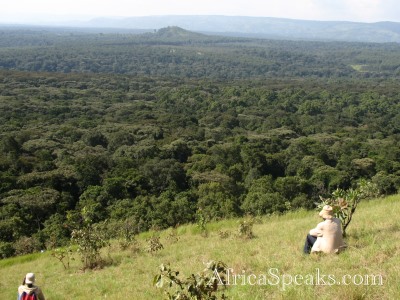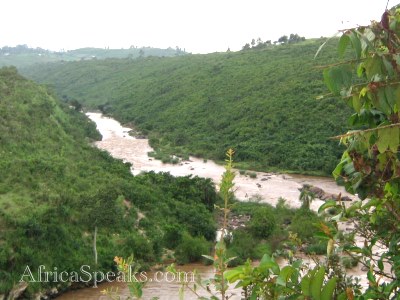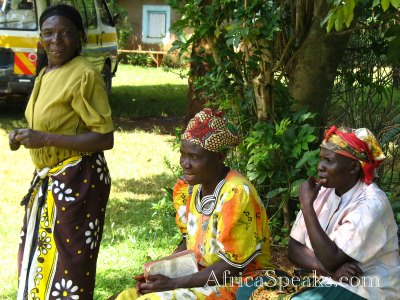The original URL of this article is:
www.africaspeaks.com/kenya/19082006.html
Agro forestry in Kenya
Academic Report
by Darceuil Duncan
August 19, 2006
UWI Students Trip to Kenya
ABSTRACT
 | | | Darceuil Duncan | |
The Republic of Kenya is a country in Eastern Africa which is bordered by Ethiopia to the north, Somalia to the east, Tanzania to the south, Uganda to the west, and Sudan to the northwest, with the Indian Ocean running down the southeast border. Kenya covers an area of 582,646 Square kilometres (224,961 sq. mi) from the coast on the Indian Ocean the Low plains rise to central highlands. The highlands are bisected by the Great Rift Valley; a fertile plateau in the west. The Kenyan Highlands comprise one of the most successful agricultural production regions in Africa. Kenya has considerable land area of wildlife habitat, including much of the Serengeti Plain.
In recent times, Kenya's forest cover has sunk to as low as 1.7%, way below the internationally recommended 10% (Understanding the new Forest Policy and Forest Act, 2005 Kenya). This is due to policy deficiencies, market failures, poor regulation, population growth and migration, rural poverty and corruption among the political elite. Consequently, Kenya has undergone a rapid re-forestation project which involves both the government and Non-governmental Organizations (NGO's) such as the Green Belt movement. Thus, new policies forged by the environmental friendly government seeks to provide directions towards a sustainable forest conservation by trying to "enhance the contribution of the forest sector in the provision of economic, social and environmental goods and services" ( Understanding the new Forest Policy and Forests Act, 2005 Kenya). This has led to the replanting of forest areas with indigenous and exotic trees such as Eucalyptus saligna. From research, it can be noted that Eucalyptus is the most commonly planted tree in Kenya for re-forestation because it is so easy to germinate, hardy, fast growth rate, its timber is versatile and its coppices (ability to grow again after being cut down). However, this is not indigenous to East Africa or Kenya at all thus, several problems have arisen. As a result, an educated decision should be made from the over 2000 other species of both indigenous and exotic trees which thrive in Kenya's soil and climates. Thus, re-forestation can be approach in three easy steps:
- Decide on the main use(s) of the trees.
- Select a species which best suits those purposes and the location for re-forestation.
- Begin to plant!
Finally, in an effort to conserve and regenerate the Kenya and the global environment as a whole it is important to accept the eco challenge and understand that the best results come from planting the right tree, in the right way, at the right place, for the right purpose- as diversity of species is better than a monoculture.
 | | Kakamega Forest - well-known for its monkeys and snakes |
INTRODUCTION
The forests of Africa cover 520 million hectares and constitute more than 17 per cent of the world's forests. They are largely concentrated in the tropical zones of Western and Central, Eastern and Southern Africa. Forests play an important economic role in many countries since it provides 6 per cent of GDP in the region, the highest in the world. Forest, in Kenya, the Caribbean and throughout the world are threatened by a combination of socio-economical factors including agricultural expansion, commercial harvesting, increased firewood collection, inappropriate land and tree tenure regimes, heavy livestock grazing, and accelerated urbanization and industrialization. Tree plantations and agro forestry are increasingly important aspects of forest rehabilitation, especially the Caribbean. Although providing significant amounts of timber, firewood and other useful products as shown in figure one of the appendices, re-forestation rates throughout Africa are far less than the rate of deforestation (FAO 1997a). The pressures on Kenya's forests will inevitably continue rising to meet the needs for fast-growing populations in rapidly urbanizing and industrializing countries, especially if most of their people remain poor. The tragedy lies in the fact that most lands that have been deforested in recent decades are not suited for long-term farming or ranching and they quickly degrade once the forest has been cut and burnt i.e. slash and burn and Shamba systems since most tropical forest soils cannot sustain annual cropping. The carrying capacity of the soil will not support intensive annual cropping without rapid, irreversible degradation. In fact, there are very few forested soils in developing countries today that are available for future agricultural expansion, underscoring the urgent need to increase agricultural production on existing farmlands rather than converting more forests to farms.
Nevertheless, conservation and sustainable development of all types of forest worldwide have now emerged as priority items on the international policy agenda, particularly in the United Nations Conference on Environment and Development (UNCED) held in Brazil in June 1992. This is due to the realization that "while forests are resilient ecosystems, there are limits to their ability to withstand environmental changes, and they degrade when these limits are exceeded" (Sustainable development of forest by J.S. Maini).
 | | Webuye River |
FINDINGS
Bungoma, Kenya can be described as part of the high potential midlands with plenty of rainfall and generally very humid. Average annual rainfall is 1100-1700mm with an annual potential evaporation of 1200-2000mm, r/E (%). Thus, Bungoma is classified as humid with typical vegetation of a moist forest. Trees that are known to be grown in this area are:
- Aberia caffra
- Acacia abyssinica
- Acacia lahai
- Acacia polyacantha
- Albizia coriaria
- Albizia gummifera*
- Albizia zygia*
- Antiaris toxicaria
- Bridela micrantha
- Calodendrum capense*
- Casuarina cunninghamiana*
- Chlorophora excelsa*
- Cordia abyssinica*
- Erythrina abyssinica
- Eucalyptus microcorys*
- Eucalyptus penicalata*
- Eucalyptus saligna*
- Faurea saligna
- Ficus natalensis*
- Gliricidia sepium*
- Gmelina arborea
- Grevillea robusta
- Harungana madagascarensis*
- Maesopsis eminii
- Markhamia platycalyx*
- Olea welwitchii*
- Prunus africanum*
- Sesbania sesban*
- Spathodea nilotica
- Teclea nobilis
- Vitex keniensis
- Warburgia ugandensis
* means indigenous trees grows abundantly in this region (A pocket directory of Trees and seeds in Kenya).
The following is a list of the uses of the indigenous trees listed above:
- Albizia gummifera*- nitrogen fixing tree, wood used as fuel, timber and in boat construction. The bark extracts feature in treatments of fevers such as malaria; crushed pods are used to cure stomach ache; crushed roots for skin diseases; powered bark as a kind of snuff for headaches and cold infusion is made to treat inflammation of the eyes.
- Albizia zygia*- primarily good timber: durable but termite proof and nitrogen fixing and provides mulch.
o Calodendrum capense*- the timber is tough but bends well, and is used in house building, for tool handles and poles, and as fuel wood and bee forage. A very beautiful tree; also planted in gardens.
- Casuarina cunninghamiana*- the hard timber is used as fuel and for poles and post. Dry leaves used as mulch; green leaves used as fodder. Roots contain a nitrogen-fixing agent.
- Chlorophora excelsa*- Although now rare, most popular timber tree in East Africa since the wood works easily, is heavy, strong and durable.
- Cordia abyssinica*- The heartwood is reddish brown; light; durable; used in the making of furniture and beehives; also as general timber and fuel. The fruit gum serves as glue; the fruit is edible. Fresh juice from the bark is applied to the affected area to treat broken bones. It is an excellent agro-forestry trees.
- Eucalyptus microcorys*- Grows only moderately fast and the wood is hard, strong, durable, termite-resistant, yields good hardwood and excellent fuel wood.
- Eucalyptus penicalata*- The timber is very hard and resistant to decay; useful for poles and in heavy construction work.
- Eucalyptus saligna*- The wood is used for furniture, veneer/plywood, posts, poles, in construction and as fuel. The species is very common in towns, where it provides both shade and decoration.
- Ficus natalensis*- The bark cloth is made from this tree. The fabric was once used for ceremonial wear and for wall hangings, and is still used for burial shrouds in central Uganda. The bark is crushed and boiled in water. The extract is then drunk as a remedy for influenza. Fresh bark is chewed and the juice swallowed to induce lactation.
- Gliricidia sepium*- Most important being a living fence and fire break and often used for fire belts around forests and farms as it is nearly "fireproof" when living. Nitrogen fixing and a fodder it is valuable for its leaves (bark, roots and seeds are poisonous). The flowers attract bee forage and valuable as mulch. The timber is also of good quality.
- Harungana madagascarensis*- Common tree on the edge of forest and noted for its blood-red sap.
- Prunus africanum/ Prunus africana*- Excellent timber used in house-building, for furniture, poles and fuel. Also used in the treatment of prostate problems and the bark are also pounded, water added and the red liquid drunk as a remedy for stomach ache; a leaf infusion is taken to improve appetite.
- Sesbania sesban*- Used in agro forestry especially in Western Kenya since it is a good coffee shade tree and soil improver. It stabilizes soil and grows well in swampy sites and the wood provides fire wood.
Source: (A pocket directory of Trees and seeds in Kenya and Field guide to common trees and shrubs of East Africa)
 | | Women of Shikunga Village at an Agro Forestry Centre |
In Bungoma Kenya, East Africa and indeed throughout sub- Saharan Africa, trees fulfill important social and economic functions. In rural areas such Bungoma, the forest serves as the principal source of energy, providing fuel wood and charcoal, and they go a long way to meeting the needs of farmers and herders. They also yield material for building and for many other domestic purposes such as traditional medicine. However, today much of the forested land has been cleared for agriculture and to fuel industry. Agriculture is the backbone of Kenya's economy since their independence since it has provided a means of economic growth. In recent times, agriculture in Kenya accounts for 35% of the total National output and employs 95% of the total labour force while simultaneously earning 65% of the country's foreign exchange and providing 80% of the population with an average hector age of 2ha per person. It may be noted that the overall problem is poverty with an increasing population and thus, agriculture provides food security of 35 million people in Kenya.
Consequently, it was evidential in Bungoma that there is an intimate and complex relationship between rural poverty and the environment i.e. deforestation. The six theoretical approaches to the poverty-environment link known as the Demographic spiral, Tragedy of commons, Kuznets curve, market failure, zero sum argument and local is best were exemplified in Bungoma, Kenya. "All these theories have some truth, but all over-simplify" (Dossier – Poverty and the Environment). For instance, the demographic spiral states, " ...as the population in a given area grows it surpasses the capacity of the natural environment to cope with it...leads to the 'vicious circle' dynamic" (Dossier – Poverty and the Environment). The pressures on Kenya's forests will inevitably continue rising to meet the needs for fast-growing populations in rapidly urbanizing and industrializing country (Demographic spiral), especially if most of their people remain poor. This has been clearly illustrated in Bungoma and the entire Kenya although the link is too complex for a simple theory. Poor agricultural practices have resulted in the lost of fertile lands.
Agriculture itself is one the major causes of environmental degradation since forested lands are cleared for cash crops, the soil profile changes, the ground water or water ways are polluted by runoff of fertilisers and pesticides and silt accumulations due to erosion. The tragedy lies in the fact that most lands that have been deforested in recent decades are not suited for long-term farming or ranching and they quickly degrade once the forest has been cut and burnt i.e. slash and burn and Shamba systems since most tropical forest soils cannot sustain annual cropping. The carrying capacity of the soil will not support intensive annual cropping without rapid, irreversible degradation. In fact, there are very few forested soils in developing countries such as in the Caribbean and Africa today that are available for future agricultural expansion, underscoring the urgent need to increase agricultural production on existing farmlands rather than converting more forests to farms. Hence, there is an extremely low forest cover of 1.7% in Kenya which is way below the internationally recommended valve of 10%. As a result, the rapid agro forestry campaign is greatly important to Kenya and, as a whole, the world. This campaign is also greatly needed in Caribbean countries since there is very little land space to deal with the numerous environmental impacts.
RECOMMENDATIONS
- An assessment of the environmental impact utilizing the Driving forces, pressure, state of the environment impacts and response (DPSIR) ) can be used to determine the environmental condition of Kenya or even the Caribbean.
- Limit the use of fertilisers in agriculture. African leaders lift taxes and tariffs on fertilisers (June 17th 2006 The Standard newspaper by Abuja Nigeria) this will result in excessive and inefficient use of fertilisers and consequently cause economic loss and environmental damage. This has been seen in other developing countries such as Indonesia when they removed their pesticide subsidies (Five Years after Rio: Innovations in Environmental Policy chapter two).
- Proper management of genetically modified crops is needed to ensure that there is limited environmental damage. In Kenya a lot of the corn grown is genetically modified (hybrid) to be resistant to pest and weeds. The inadequate regulation of the products of the biotech revolution will lead to the spread of environmentally destructive genetic pollution and wholesale loss of biodiversity.
- There is a need for agricultural and environmental skill training for the small farmers of Kenya. This will ensure that agricultural practices are managed efficiently to minimize environmental degradation.
- Many parts of Kenya are without trees due to human activities, climatic conditions or due to poor types of soil hence, tree nursery agriculture extension information should be provided for the rural communities as a service of the government in order to promote environmental conservation. Thus, a standardised manual should be provided at no cost which covers the nursery establishment, selection of site, seed selection etc.
- Soil and land surveying should be carried out in an effort to combat major drought and soil difference for one region to another in Kenya.
- In an effort to conserve and regenerate the Kenya and the global environment as a whole it is important to accept the eco challenge and understand that the best results come from planting the right tree, in the right way, at the right place, for the right purpose- as diversity of species is better than a monoculture. Thus, re-forestation can be approach in three easy steps:
- Decide on the main use(s) of the trees.
- Select a species which best suits those purposes and the location for re-forestation.
- Begin to plant!
CONCLUSION
It is unlikely in the foreseeable future that reforestation can be used to alleviate major environmental problems affiliated with deforestation and its negative socioeconomic impacts. Based on the most recent estimates of the rates of deforestation, and assuming that 75 per cent of forest losses are attributable to agricultural expansion, it is estimated that over the next 25 years the agriculture sector will require an additional 250 to 300 million hectares of new land to accommodate the demands of commercial farming, subsistence cropping, pasture and range development (put source). Most of this increase in land area will come at the expense of tropical forests. The agriculture sector must be challenged to find appropriate solutions.
Through improved protection and management of the remaining forests, through well-targeted socioeconomic development programs, and through policy and institutional reforms, deforestation can be brought under control. The technologies for making a difference are known, so are the approaches needed to implement them. It is time for all peoples to renew their commitment to live in harmony with the environment through sustainable development before they are lost forever.
REFERENCE
Book:
- Teel, Wayne. A pocket directory of Trees and seeds in Kenya and Field guide to common trees and shrubs of East Africa
- Dharani, Najma. Field guide to common trees and shrubs of East Africa. East Africa Publishing company. 2005
- Ludeki, Jael. Wamukoya, George. Walubengo, Dominic. Understanding the new Forest Policy and Forests Act, 2005 Kenya. Ministry of Environment, Kenya
- Sustainable development of forest by J.S. Maini. AM17B Introduction to Agro-Environmental Management, The University of the West Indies, St. Augustine.
- Dossier – Poverty and the Environment. AM17B Introduction to Agro-Environmental Management, The University of the West Indies, St. Augustine.
- Five Years after Rio: Innovations in Environmental Policy chapter two. Environmentally sustainable development studies and monograph series no.18. AM17B Introduction to Agro-Environmental Management, The University of the West Indies, St. Augustine.
- The Phillip's Kenya Primary Atlas Revised edition. East Africa Educational Publishers.1996
Websites:
Other:
Abuja, Nigeria. African leaders lift taxes and tariffs on fertilisers. June 17th 2006 The Standard newspaper, Kenya.
UWI Students Trip to Kenya in pictures:
http://rastafarispeaks.com/gallery/Trip_to_Africa_2006
|
|